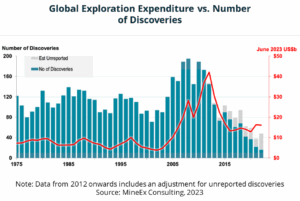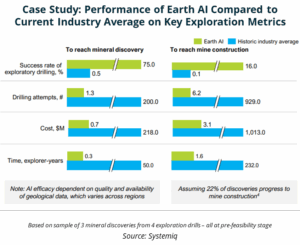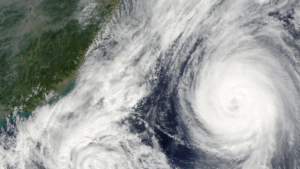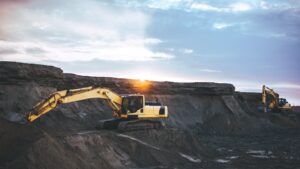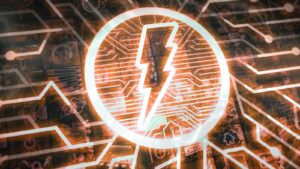Rock Solid AI: How Digital Tools Are Unearthing a New Era of Mining Exploration
Why Mineral Exploration Needs a Rethink
The world needs vast amounts of critical minerals like copper, nickel, and lithium to build electric vehicles, renewable energy infrastructure, and data centers. But the easy-to-find deposits are mostly depleted, and discovery rates for new mineral deposits have plummeted by ~75% in the last decade.
Traditional exploration methods rely on slow, capital-intensive drilling campaigns with low success rates. The average drill success rates are as low as 0.5% and greenfield projects face a 1 in 5,000 chance of commercial success. These odds are forcing the industry to spend more money for less return, slowing the ability to secure new supplies of the metals essential for the energy transition and advanced manufacturing.
A Game-Changer: AI-Powered Exploration
By analyzing massive datasets including historical drilling logs, geochemical surveys, satellite imagery, and geophysical data, AI platforms can identify patterns and mineralization clues invisible to human geologists. AI-driven mineral targeting has flipped the odds, with early commercial results showing drill success rates jumping to ~75%. Companies like KoBold Metals and Earth AI have used AI to discover major deposits, such as KoBold’s recent Mingomba copper find in Zambia.
By targeting drill sites more precisely, AI dramatically cuts the time and money spent on fruitless exploration. Industry estimates suggest AI-driven exploration could deliver annual savings of $290B–$390B by 2035, reducing discovery costs by as much as 80%.
Another innovator, VerAI, applies their AI platform to directly identify subsurface mineralization, with a strategy centered on internal asset generation. Once a target is identified, VerAI stakes and holds the mineral rights and partners to develop its assets. This type of unique business model appeals to investors seeking exposure to critical mineral assets and its related significant upside, without the operational risk associated with mining, positioning VerAI as a scalable entry point for high-probability early-stage mineral value creation.
Unlocking the Unseen with Hyperspectral Imaging and Quantum Sensing
But AI alone isn’t the only industry disruption we are seeing. Hyperspectral satellites and drones now complement AI by scanning terrains in dozens or hundreds of light wavelengths, far beyond what the human eye can detect. Different minerals reflect light uniquely, creating a spectral fingerprint. Platforms like Matter Intelligence and TerraEye map surface mineralogy remotely, even under vegetation or shallow cover, revealing new targets in places inaccessible to traditional ground crews.
Quantum sensing adds another layer: advanced gravimeters and magnetometers can detect subtle variations in subsurface density and magnetic properties, even through complex geology. Technologies created by innovators such as Atomionics allow explorers to locate dense ore bodies hidden under layers of rock, clay, or sand, expanding the frontier of discoverable resources.
Digital Twins: Virtual Exploration Comes of Age
Once promising targets are identified, interactive 3D digital twins take over. These detailed virtual models merge historical and real-time data, from drone surveys, borehole samples, downhole sensors, and seismic imaging, to simulate geological scenarios. Unlike static maps, digital twins update dynamically as new data arrives, allowing geologists to refine models, reduce uncertainty, and plan drill programs more effectively.
Companies like Akselos and Skycatch are pioneering these digital twin solutions, offering explorers the ability to “walk” through underground structures in virtual reality, test multiple interpretations of the geology, and optimize drilling campaigns before spending millions on the ground.
Why Mining Has Been Slow to Change, and Why That’s Changing
The mining industry is famously conservative. Exploration is risky, expensive, and time-consuming. A single failed campaign can cost hundreds of millions of dollars. As a result, many mining executives prefer to see new technologies proven elsewhere before adopting them themselves. There’s a running notion in the mining industry that says miners typically want to be the third or fourth to try something new, rather than the first.
But this caution is now colliding with reality: skyrocketing demand, workforce shortages, and regulatory pressures are forcing miners to act. Many experienced geologists are retiring, leaving talent gaps that AI and automation can help fill. Environmental and social pressures make traditional “dig-and-hope” exploration strategies less acceptable, while growing delays in permitting increase the cost of lengthy exploration programs.
Junior and mid-tier miners, often more agile and in greater need of cost-effective differentiation, are leading the charge in adopting AI and digital exploration tools. Case studies like TerraEye, which has engaged smaller miners with remote sensing solutions, show how innovators can break into an industry traditionally dominated by cautious majors, and may be better served tailoring their solutions to this customer segment.
Data: The Hidden Battleground
One of the biggest hurdles to scaling AI exploration is data. Mining data is often fragmented across decades, companies, and formats. Public datasets can be sparse or outdated, and proprietary data can give huge competitive advantages. KoBold Metals’ early access to Rio Tinto’s exploration datasets helped it train better AI models, showing how control of data can create an insurmountable lead.
Bias in training data is another challenge: if AI models are trained only on data from known deposits, they risk reinforcing old exploration patterns instead of discovering entirely new types of deposits.
Additionally, even with great data, deploying AI in the field isn’t that straightforward. Exploration often happens in off-grid regions with limited digital infrastructure, making it hard to run cloud-based AI platforms or transmit data. Innovators like Qiyuan Core Power, which is developing 5G-enabled solutions for remote mining sites, show that vertical integration of connectivity may be essential for effective digital exploration in the most promising but hardest-to-reach areas.
Keep an Eye Out For…
- High-profile AI-discovered mineral deposits reaching commercial development stages will boost market trust and de-risk perception. This will drive exploration companies to follow suit, especially mid-tier and junior miners lacking large in-house technical teams.
- Growing number of acquisitions by mining service providers (e.g., Master Drilling, Weir) looking to incorporate digital innovation to stay competitive signal that AI capability is no longer optional and is becoming embedded into standard service offerings.
- Innovators are focusing on improving model explainability and user interfaces to gain the trust of geologists and decision-makers who are wary of “black box” systems, i.e., when geologists can trace, interrogate, and manipulate model outputs.
- Innovators are growing a pipeline of successful reference customers and repeat deployments in different geographies (Australia, Africa, South America) to show model robustness and geographic flexibility, e.g., Plotlogic and GeologicAI have demonstrated deployment in several geographies with further plans for expansion.
As Part 2 will explore, the same digital tools that revolutionize exploration are also reshaping how we mine, focusing on making operations smarter, cleaner, and more efficient.
